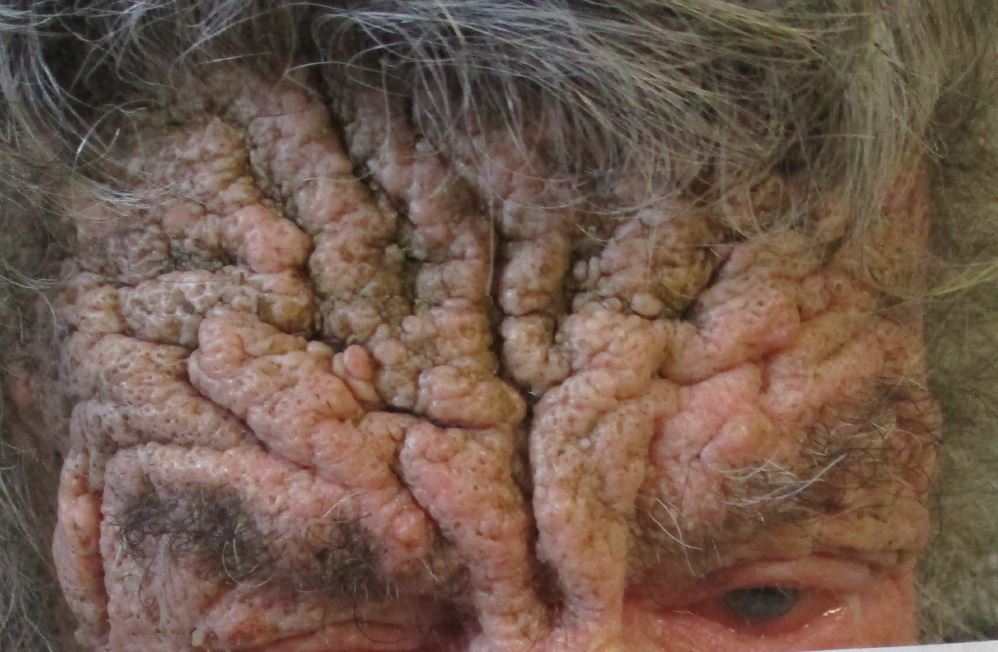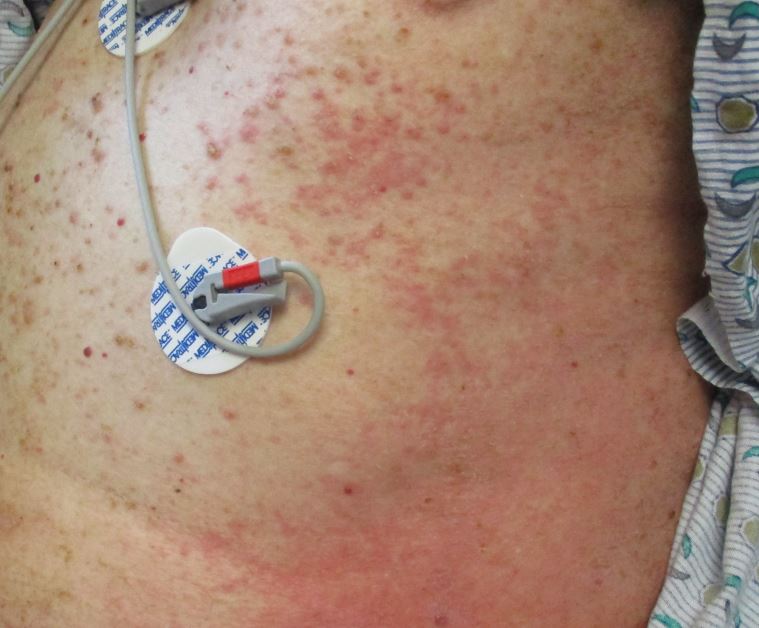20 July 2022 - Case of the Month #517
All cases are archived on our website. To view them sorted by case number, diagnosis or category, visit our main Case of the Month page. To subscribe or unsubscribe to Case of the Month or our other email lists, click here.
Thanks to Dr. Viktoryia Kazlouskaya, University of Pittsburgh, Pittsburgh, Pennsylvania, USA, for contributing this case and discussion and to Dr. Jonathan Ho, University of the West Indies, Mona, Jamaica for reviewing the discussion.

Case of the Month #517
Clinical history:
A man in his 50s presented with leonine (resembling a lion) facies and keratotic papules all over his body. He mentioned that the condition has been present since he was a child and that his mother and siblings had similar skin features. A skin biopsy was obtained.
Clinical and histopathology images:
What is your diagnosis?
Diagnosis: Darier disease
Test question (answer at the end):
Where is the abnormal protein located in Darier disease?
A. Cytoplasm
B. Endoplasmic reticulum
C. Golgi apparatus
D. Mitochondria
E. Nucleus
Discussion:
Darier disease (keratosis follicularis) is an autosomal dominant hereditary acantholytic condition. It has high penetrance with features of the condition seen in nearly every generation; however, the severity of the condition varies. The condition is rare, with prevalence of 1 in 100,000 (Am J Clin Dermatol 2003;4:97).
Mutations of the gene (ATP2A2) encoding sarco / endoplasmic reticulum calcium adenosine triphosphate pump (SERCA2) play the main role in the pathogenesis of Darier disease.
The condition usually starts in the 20 - 30s. The classical presentation of Darier disease is the presence of greasy papules on the seborrheic areas (image 2). Lesions may form large exophytic plaques with erosions and malodor. Coalescent papules on the face may cause a leonine appearance (image 1). Small discrete verruciform papules may appear early on the dorsal hands (acrokeratosis verruciformis). In some cases, white small hypopigmented macules are present (Indian Dermatol Online J 2020;12:378). Longitudinal erythronychia with a V shaped nick is commonly seen on the nails. A cobblestone pattern with overgrowths is sometimes seen on the mucous membranes (Int J Dermatol 2021;60:775). Rare clinical variants of Darier disease include comedonal, linear, acral, hemorrhagic, vesiculobullous, localized and cornifying types (J Dtsch Dermatol Ges 2020;18:1501, Actas Dermosifiliogr 2017;108:e49). Bacterial and viral infections may complicate skin eruptions. Usually, there are no systemic associations; however, a link between psychiatric diseases and Darier disease has been suggested (Clin Case Rep 2021;9:e04263). Swelling and obstruction of salivary glands has been described in some patients with Darier disease.
The differential diagnosis is broad and depends on the clinical presentation. The condition should be differentiated from seborrheic dermatitis, Hailey - Hailey disease, Grover disease, pemphigus vegetans and eczemas. Comedonal forms may resemble acne and acneiform eruptions. Linear Darier disease has common features with linear psoriasis, inflammatory linear verrucous epidermal nevus (ILVEN), lichen striatus and blaschkitis.
There is no unique treatment for Darier disease. General measures include prevention of excessive sweating, avoiding heat, moisturizing skin and use of antimicrobial cleansers to prevent infections. Use of topical and systemic retinoids is the most effective current treatment of the condition. Laser destruction of the lesions and botulinum neurotoxin injections may be helpful as well (J Dtsch Dermatol Ges 2021;19:1478, Toxins (Basel) 2021;13:120).
Test question answer:
B. Endoplasmic reticulum. An abnormal SERCA2 protein is located in the endoplasmic reticulum and plays a role in the Ca2+ signaling pathway regulating cell to cell adhesion and differentiation of the epidermis (Nat Genet 1999;21:271).
All cases are archived on our website. To view them sorted by case number, diagnosis or category, visit our main Case of the Month page. To subscribe or unsubscribe to Case of the Month or our other email lists, click here.
Thanks to Dr. Viktoryia Kazlouskaya, University of Pittsburgh, Pittsburgh, Pennsylvania, USA, for contributing this case and discussion and to Dr. Jonathan Ho, University of the West Indies, Mona, Jamaica for reviewing the discussion.

Case of the Month #517
Clinical history:
A man in his 50s presented with leonine (resembling a lion) facies and keratotic papules all over his body. He mentioned that the condition has been present since he was a child and that his mother and siblings had similar skin features. A skin biopsy was obtained.
Clinical and histopathology images:
What is your diagnosis?
Click here for diagnosis, test question and discussion:
Diagnosis: Darier disease
Test question (answer at the end):
Where is the abnormal protein located in Darier disease?
A. Cytoplasm
B. Endoplasmic reticulum
C. Golgi apparatus
D. Mitochondria
E. Nucleus
Discussion:
Darier disease (keratosis follicularis) is an autosomal dominant hereditary acantholytic condition. It has high penetrance with features of the condition seen in nearly every generation; however, the severity of the condition varies. The condition is rare, with prevalence of 1 in 100,000 (Am J Clin Dermatol 2003;4:97).
Mutations of the gene (ATP2A2) encoding sarco / endoplasmic reticulum calcium adenosine triphosphate pump (SERCA2) play the main role in the pathogenesis of Darier disease.
The condition usually starts in the 20 - 30s. The classical presentation of Darier disease is the presence of greasy papules on the seborrheic areas (image 2). Lesions may form large exophytic plaques with erosions and malodor. Coalescent papules on the face may cause a leonine appearance (image 1). Small discrete verruciform papules may appear early on the dorsal hands (acrokeratosis verruciformis). In some cases, white small hypopigmented macules are present (Indian Dermatol Online J 2020;12:378). Longitudinal erythronychia with a V shaped nick is commonly seen on the nails. A cobblestone pattern with overgrowths is sometimes seen on the mucous membranes (Int J Dermatol 2021;60:775). Rare clinical variants of Darier disease include comedonal, linear, acral, hemorrhagic, vesiculobullous, localized and cornifying types (J Dtsch Dermatol Ges 2020;18:1501, Actas Dermosifiliogr 2017;108:e49). Bacterial and viral infections may complicate skin eruptions. Usually, there are no systemic associations; however, a link between psychiatric diseases and Darier disease has been suggested (Clin Case Rep 2021;9:e04263). Swelling and obstruction of salivary glands has been described in some patients with Darier disease.
The differential diagnosis is broad and depends on the clinical presentation. The condition should be differentiated from seborrheic dermatitis, Hailey - Hailey disease, Grover disease, pemphigus vegetans and eczemas. Comedonal forms may resemble acne and acneiform eruptions. Linear Darier disease has common features with linear psoriasis, inflammatory linear verrucous epidermal nevus (ILVEN), lichen striatus and blaschkitis.
There is no unique treatment for Darier disease. General measures include prevention of excessive sweating, avoiding heat, moisturizing skin and use of antimicrobial cleansers to prevent infections. Use of topical and systemic retinoids is the most effective current treatment of the condition. Laser destruction of the lesions and botulinum neurotoxin injections may be helpful as well (J Dtsch Dermatol Ges 2021;19:1478, Toxins (Basel) 2021;13:120).
Test question answer:
B. Endoplasmic reticulum. An abnormal SERCA2 protein is located in the endoplasmic reticulum and plays a role in the Ca2+ signaling pathway regulating cell to cell adhesion and differentiation of the epidermis (Nat Genet 1999;21:271).



